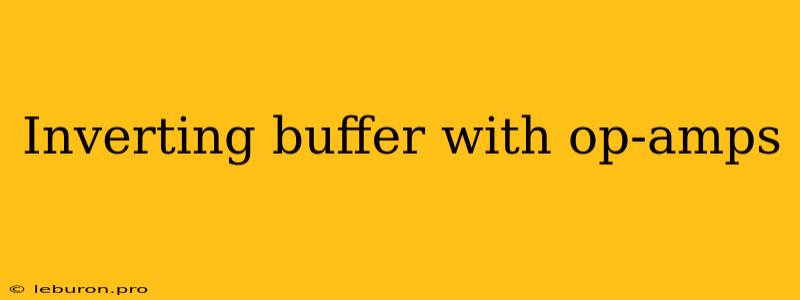An inverting buffer, also known as a unity-gain inverting amplifier, is a fundamental circuit configuration in operational amplifier (op-amp) applications. It utilizes the op-amp's high open-loop gain and feedback mechanism to provide a signal inversion without amplification. This article will delve into the working principles, characteristics, and applications of an inverting buffer with op-amps, providing a comprehensive understanding of this essential circuit.
Understanding the Inverting Buffer
The inverting buffer configuration uses an op-amp with the non-inverting input connected to ground and the inverting input connected to the input signal. A feedback resistor connects the output to the inverting input, forming a closed-loop circuit. The output signal is taken from the output of the op-amp.
How it Works
The op-amp operates based on the principle of negative feedback. Due to the high open-loop gain, the op-amp strives to maintain a near-zero voltage difference between its input terminals. When an input signal is applied to the inverting input, the op-amp amplifies the difference between the inputs, driving the output in the opposite direction to reduce the voltage difference.
The feedback resistor plays a crucial role in maintaining this balance. As the output voltage changes, the feedback signal alters the voltage at the inverting input. This negative feedback mechanism ensures that the voltage difference between the inputs remains negligible, resulting in a virtual ground at the inverting input.
Key Features
- Unity Gain: The output signal amplitude is the same as the input signal amplitude, leading to a gain of 1.
- Signal Inversion: The output signal is inverted with respect to the input signal, meaning that a positive input produces a negative output and vice versa.
- High Input Impedance: The inverting buffer presents a high input impedance to the signal source, minimizing loading effects.
- Low Output Impedance: The output impedance of the inverting buffer is very low, enabling it to drive loads without significant voltage drops.
Applications of Inverting Buffer with Op-amps
Inverting buffers find widespread use in various electronic circuits due to their versatility and simplicity. Some common applications include:
1. Signal Level Shifting
Inverting buffers can be used to shift the DC level of a signal without affecting its AC component. This is achieved by introducing a DC voltage at the non-inverting input terminal. The output signal will have the same AC waveform as the input but with a shifted DC level.
2. Impedance Matching
Inverting buffers can be used to match the impedances of different circuits. For example, a high-impedance source can be connected to a low-impedance load using an inverting buffer to prevent signal attenuation.
3. Current-to-Voltage Conversion
An inverting buffer can be employed in conjunction with a current-to-voltage converter to convert an input current into a proportional voltage. This is accomplished by connecting the current source to the inverting input and using a feedback resistor to create a voltage drop across the feedback resistor proportional to the input current.
4. Active Load
Inverting buffers can be utilized as active loads in amplifier circuits. The high input impedance and low output impedance of the buffer provide a stable load for the amplifier, improving its performance.
5. Buffering
Inverting buffers can be employed as buffers to isolate different parts of a circuit. By placing an inverting buffer between two circuits, one circuit's output is not affected by the load characteristics of the other circuit.
Advantages and Disadvantages of Inverting Buffer
Advantages:
- High Input Impedance: Minimizes loading effects on the input signal source.
- Low Output Impedance: Enables efficient driving of loads without significant voltage drops.
- Simplicity: Simple and straightforward circuit configuration.
- Versatility: Applicable in various electronic circuits for signal level shifting, impedance matching, current-to-voltage conversion, active loading, and buffering.
Disadvantages:
- Signal Inversion: The output signal is inverted with respect to the input signal, which may require additional circuitry for certain applications.
- Limited Bandwidth: The performance of the inverting buffer is limited by the bandwidth of the op-amp used.
Conclusion
The inverting buffer with op-amps is a fundamental building block in analog circuit design, offering unity gain and signal inversion. Its high input impedance, low output impedance, and simplicity make it a versatile tool for various applications. By understanding the working principles and characteristics of the inverting buffer, engineers can effectively utilize it to enhance circuit performance and achieve desired signal manipulations. Further exploration of its applications and variations can provide deeper insights into its capabilities and limitations.
